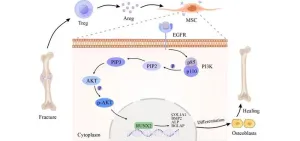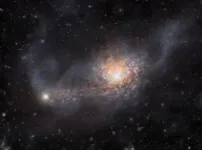(Press-News.org) London, UK, 30 August 2024: The 2024 ESC Guidelines for the management of atrial fibrillation, developed in collaboration with the European Association of Cardio-Thoracic Surgery (EACTS), contain a number of new approaches and treatment-specific recommendations to help manage the surging numbers of patients with AF worldwide.
“Atrial fibrillation (AF) is one of the most commonly encountered heart conditions, with a broad impact on all health services across primary, secondary and tertiary care,” says Guidelines Chair Professor Isabelle C. Van Gelder, University Medical Centre Groningen, Groningen, The Netherlands. “The prevalence of AF is expected to double by 2050 as a consequence of the ageing population, an increasing burden of comorbidities, improved awareness, and new technologies for detection.”
“The impact of AF is variable across individual patients; however, morbidity from AF remains highly concerning,” adds Guidelines Chair Professor Dipak Kotecha, University of Birmingham, UK. “Patients with AF can suffer from a variety of symptoms and poor quality of life. Stroke and heart failure as consequences of AF are now well appreciated by healthcare professionals, but AF is also linked to a range of other thromboembolic outcomes. These include subclinical cerebral damage (potentially leading to vascular dementia), and thromboembolism to every other organ, all of which contribute to the higher risk of death associated with AF.”
The 2024 guidelines stress the importance of optimal care according to the new AF-CARE pathway, which has been designed to ensure that each and every patient with AF can benefit from recent scientific advances: [C] Comorbidity and risk factor management; [A] Avoid stroke and thromboembolism; [R] Reduce symptoms by rate and rhythm control; and [E] Evaluation and dynamic reassessment.
The new guidelines also stress the importance of shared decision making on treatments and care, including both patients and a multidisciplinary team. Education of patients, family members and healthcare professionals are emphasised to ensure that all are empowered to make the right treatment choice for each patient. There is also a focus on equal care, stressing the importance of avoiding health inequalities based on gender, ethnicity, disability, and socioeconomic factors.
“The comorbidities sections in these new guidelines highlight that AF cannot be viewed in isolation. Thorough evaluation and management of comorbidities and risk factors are critical to all aspects of care for patients with AF to avoid recurrence and progression of AF, improve success of treatments, and prevent AF-related adverse outcomes,” explains Professor Van Gelder. “There should be an increased focus on the range of conditions and lifestyle factors where there is growing evidence of impact on AF and patient care”.
The new guidelines also focus on recent clinical trials and research studies that can change the routine management of patients with AF for the better. “The guideline task force has carefully evaluated the current evidence-base, with patient pathways that can help to achieve better implementation of recommendations to improve patient wellbeing,” says Professor Kotecha. The key new features are: (1) broader application of appropriate anticoagulant therapy, and using the CHA2DS2-VA score (without gender) to assist in decision-making; (2) a ‘safety-first’ approach throughout, for example by delaying cardioversion if AF duration exceeds 24 hours, or considering fully any potential side effects of antiarrhythmic drugs; and (3) integrating rate and rhythm control, with shared-decision making on referral for catheter and surgical ablation.
The authors conclude by making clear that dynamic evaluation and reassessment is needed for patients with AF. They say: “Healthcare teams in primary and secondary care need to periodically reassess therapy and give attention to new modifiable risk factors that could slow or reverse the progression of AF, increase quality of life, and prevent adverse outcomes.” A patient version of the guidelines will be released simultaneously, co-written by the patient and public representatives on the taskforce.
ENDS
Disclosures: Please see full guidelines for all disclosures.
References and notes
The Guidelines “2024 ESC Guidelines for the Management of Atrial Fibrillation” will be discussed during the session “2024 ESC Guidelines overview”, Friday 30 August at 8:15am BST in room London.
2024 ESC Guidelines for the Management of Atrial Fibrillation, European Heart Journal, 2024, https://doi.org/10.1093/eurheartj/ehae176
ESC Press Office
Tel: +33 6 61 40 18 84
Email: press@escardio.org
The hashtag for ESC Congress 2024 is #ESCCongress
Follow us on X @ESCardioNews
Journalists are invited to become accredited and register here.
Check out the ESC Media and Embargo Policy.
About ESC Congress 2024
It is the world’s largest gathering of cardiovascular professionals, disseminating ground-breaking science both onsite in London and online – from 30 August to 2 September. Explore the scientific programme. More information is available from the ESC Press Office at press@escardio.org.
About the European Society of Cardiology
The European Society of Cardiology brings together health care professionals from more than 150 countries, working to advance cardiovascular medicine and help people lead longer, healthier lives.
END
Atrial fibrillation guidelines focus on shared and equal care, patient empowerment, comorbidities, evidence-based management and dynamic re-evaluation
AF prevalence expected to double in coming decades – new ESC Guidelines focus on tackling comorbidities, education for patients and families, and shared decision making
2024-08-30
ELSE PRESS RELEASES FROM THIS DATE:
Two thirds of deaths related to high BMI are due to cardiovascular diseases - ESC Clinical Consensus Statement on Obesity and Cardiovascular Disease
2024-08-30
London, United Kingdom – 30 August 2024: The ESC Clinical Consensus Statement on Obesity and Cardiovascular Disease, presented at this year’s ESC Congress (London, UK, 30 August to 2 September) summarises current evidence on the epidemiology and aetiology of obesity; the interplay between obesity, cardiovascular risk factors and cardiac conditions; the clinical management of patients with cardiac disease and obesity; and weight loss strategies including lifestyle changes, interventional procedures, and anti-obesity medications with particular focus ...
Prehospital pulse-dose glucocorticoid in ST-segment elevation myocardial infarction
2024-08-30
About The Study: In patients with ST-segment elevation myocardial infarction, treatment with prehospital pulse-dose glucocorticoid did not reduce final infarct size after 3 months. However, the trial was likely underpowered as the final infarct size was smaller than anticipated. The glucocorticoid group had improved acute parameters compared with placebo.
Corresponding Author: To contact the corresponding author, Jasmine Melissa Madsen, MD, email jasmine.melissa.madsen.01@regionh.dk.
To access the embargoed study: Visit our For The Media website at this link https://media.jamanetwork.com/
(doi:10.1001/jamacardio.2024.2298)
Editor’s ...
Effects of sacubitril/valsartan on all-cause hospitalizations in heart failure
2024-08-30
About The Study: In this post hoc pooled analysis of 13,194 patients with chronic heart failure (HF) in the PARADIGM-HF and PARAGON-HF randomized clinical trials, sacubitril/valsartan significantly reduced hospitalization for any reason, with benefits most apparent in patients with a left ventricular ejection fraction below normal. This reduction appeared to be principally driven by lower rates of cardiac and pulmonary hospitalizations.
Corresponding Author: To contact the corresponding author, Muthiah Vaduganathan, MD, MPH, email mvaduganathan@bwh.harvard.edu.
To ...
Promising antibiotic candidates discovered in microbes deep in the Arctic Sea
2024-08-30
Antibiotics are the linchpin of modern medicine: without them, anyone with open wounds or needing to undergo surgery would be at constant risk of dangerous infections. Yet we continue to face a global antibiotics crisis, as more and more resistant strains of bacteria are evolving, while the rate of discovery of fundamentally new antibiotics has been much slower.
But there is reason for hope: 70% of all currently licensed antibiotics have been derived from actinobacteria in the soil, and most environments on Earth have not yet ...
A distinct “repair” role of regulatory T cells in fracture healing
2024-08-30
The study uncovers a unique reparative function of regulatory T cells (Tregs) in the process of fracture healing, a discovery that adds a new dimension to our understanding of the immune response in tissue regeneration. Tregs, a subset of T cells known for their role in maintaining immune tolerance and preventing autoimmunity, are now shown to play a critical part in the intricate interplay between the immune system and bone repair.
Fracture healing is a complex process that involves a sequence of events, including inflammation, repair, and remodeling. While the initial ...
Dancing galaxies make a monster at the cosmic dawn
2024-08-30
Astronomers have spotted a pair of galaxies in the act of merging 12.8 billion years ago. The characteristics of these galaxies indicate that the merger will form a monster galaxy, one of the brightest types of objects in the Universe. These results are important for understanding the early evolution of galaxies and black holes in the early Universe.
Quasars are bright objects powered by matter falling into a supermassive black hole at the center of a galaxy in the early Universe. The most accepted theory is that when two gas-rich galaxies merge to form a single larger galaxy, the gravitational interaction of the two galaxies causes gas to fall towards the supermassive ...
Drought risk and awareness gaps in global society
2024-08-30
Natural disasters have threatened to human beings and the ecosystem. Among the various natural disasters, drought is one of the most insidious and costliest, adversely affecting the global economy and livelihoods. Unlike sudden disasters such as earthquakes or hurricanes, drought is a slow-onset phenomenon that gradually intensifies. This prolonged nature of drought often results in the shortage of drinking water and the disruption of local economies.
The Slow Onset and Impact of Drought
Drought creeps in gradually, often going unnoticed until it reaches a critical stage. This slow progression makes drought particularly challenging to manage and mitigate. Initially, ...
UAF scientist’s method could give months’ warning of major earthquakes
2024-08-30
The public could have days or months of warning about a major earthquake through identification of prior low-level tectonic unrest over large areas, according to research by a University of Alaska Fairbanks scientist who analyzed two major quakes in Alaska and California.
The work was led by research assistant professor Társilo Girona of the UAF Geophysical Institute.
Girona, a geophysicist and data scientist, studies precursory activity of volcanic eruptions and earthquakes. Geologist Kyriaki Drymoni of the Ludwig-Maximilians-Universität in Munich, Germany, is a co-author.
The ...
Consensus paper: Carcinogenicity of gene therapies
2024-08-30
Researchers from the University of Pennsylvania, Perelman School of Medicine, Gene Therapy Program, and Moderna, have shown that repeated administration of lipid nanoparticle-encapsulated mRNA therapy significantly extended survival and reduced serum leucine levels in a mouse model of maple syrup urine disease (MSUD). Click here to read the article now.
The researchers, led by James Wilson, MD, PhD, from the University of Pennsylvania, Perelman School of Medicine, evaluated a lipid nanoparticle-based treatment approach to address all possible genetic mutations that can cause MSUD.
“Repeated intravenous delivery ...
HeterMM: Applying in-DRAM index to heterogeneous memory-based key-value stores
2024-08-30
Emerging byte-addressable storage technologies, such as NVM, provide a more cost-effective and larger-capacity alternative to DRAM, presenting new opportunities to address the high cost, limited capacity, and volatility of in-memory key-value (KV) stores. Numerous efforts have been dedicated to redesigning conventional structures on NVM. However, they were challenged by the substantial engineering cost and increased complexity to be integrated into existing systems. Thus, a general framework to apply existing indexes to KV stores on NVM becomes more attractive.
To solve the problems, a research team led by Xuan Zhou published their new research on ...
LAST 30 PRESS RELEASES:
Scientists discover ‘platypus galaxies’ in the early universe
Seeing thyroid cancer in a new light: when AI meets label-free imaging in the operating room
Neutrophil-to-lymphocyte ratio may aid risk stratification in depressive disorder
2026 Seismological Society of America Annual Meeting
AI-powered ECG analysis offers promising path for early detection of chronic obstructive pulmonary disease, says Mount Sinai researchers
GIMM uncovers flaws in lab-grown heart cells and paves the way for improved treatments
Cracking the evolutionary code of sleep
Medications could help the aging brain cope with surgery, memory impairment
Back pain linked to worse sleep years later in men over 65, according to study
CDC urges ‘shared decision-making’ on some childhood vaccines; many unclear about what that means
New research finds that an ‘equal treatment’ approach to economic opportunity advertising can backfire
Researchers create shape-shifting, self-navigating microparticles
Science army mobilizes to map US soil microbiome
Researchers develop new tools to turn grain crops into biosensors
Do supervised consumption sites bring increased crime? Study suggests that’s a myth
New mass spec innovation could transform research
Maternal nativity, race, and ethnicity and infant mortality in the US
Migration-related trauma among asylum seekers exposed to the migrant protection protocols
Jupiter’s moon Europa has a seafloor that may be quiet and lifeless
SwRI upgrades nuclear magnetic resonance laboratory for pharmaceutical R&D
House sparrows in northern Norway can help us save other endangered animals
Crohn's & Colitis Foundation survey reveals more than 1/3 of young adults with IBD face step therapy insurance barriers
Tethered UAV autonomous knotting on environmental structures for transport
Decentralized social media platforms unlock authentic consumer feedback
American Pediatric Society announces Vanderbilt University School of Medicine as host institution for APS Howland Visiting Professor Program
Scientists discover first method to safely back up quantum information
A role for orange pigments in birds and human redheads
Pathways to net-zero greenhouse gas emissions for Southeast Asia
A JBNU–KIMS collaborative study on a cost-effective alloy matches superalloys for power plants and energy infrastructure
New study overturns long-held model of how plants coordinate immune responses.
[Press-News.org] Atrial fibrillation guidelines focus on shared and equal care, patient empowerment, comorbidities, evidence-based management and dynamic re-evaluationAF prevalence expected to double in coming decades – new ESC Guidelines focus on tackling comorbidities, education for patients and families, and shared decision making





